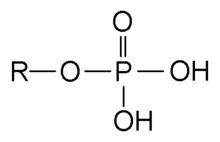Inositol phosphate
From Wikipedia, the free encyclopedia

Phosphate group
Inositol phosphates are a group of mono- to polyphosphorylated inositols. They play crucial roles in diverse cellular functions, such as cell growth, apoptosis, cell migration, endocytosis, and cell differentiation. The group comprises:
- inositol monophosphate (IP)
- inositol bisphosphate (IP2)
- inositol trisphosphate (IP3)
- inositol pentakisphosphate (IP5)
- inositol hexaphosphate (IP6) also known as phytic acid, or phytate (as a salt).
Functions
Inositol triphosphate
Inositol trisphosphates act on the inositol triphosphate receptor to release calcium into the cytoplasm. Further reading: Function of calcium in humans
Other
Inositol tetra-, penta-, and hexa-phosphates have been implicated in gene expression[1] and Steger[2] (both in Science Magazine).
References
- ↑ Shen, X; Xiao, H; Ranallo, R; Wu, WH; Wu, C (2003). "Modulation of ATP-dependent chromatin-remodeling complexes by inositol polyphosphates". Science 299 (5603): 112–4. doi:10.1126/science.1078068. PMID 12434013.
- ↑ Steger, DJ; Haswell, ES; Miller, AL; Wente, SR; O'Shea, EK (2003). "Regulation of chromatin remodeling by inositol polyphosphates". Science 299 (5603): 114–6. doi:10.1126/science.1078062. PMC 1458531. PMID 12434012.
External links
- An Image of Inositol
- Inositol Phosphates at the US National Library of Medicine Medical Subject Headings (MeSH)
| |||||||||||||||||||||||||||||||||||
This article is issued from Wikipedia. The text is available under the Creative Commons Attribution/Share Alike; additional terms may apply for the media files.
